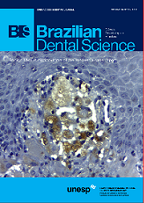Influence of simulated pulpal pressure on the variation of intrapulpal temperature during adhesive system light-curing
DOI:
https://doi.org/10.14295/bds.2017.v20i2.1409Resumo
Objective: To evaluate the effects of simulated pulpal pressure (SPP) on the variation of intrapulpal temperature (DT) during light-curing of the adhesive system. Material e methods: One hundred sound human molars were sectioned from the highest pulp horn to obtain a 2-mm of thickness dentin. The specimens were randomly divided into two groups: (n=50), according to the presence or absence of SPP (15 cm H2O). The specimens were sequentially treated as follows: 37% phosphoric acid (Scotchbond Universal; 3M/ESPE), adhesive system (Scotchbond Universal/3M ESPE) and light-curing (10 seconds). DT was evaluated during adhesive light-curing with a K-type thermometer put inside the pulp chamber. Data were analysed by using Mann-Whitney’s test (at 5%). Results: According to Mann-Whitney’s test, the absence group presented a DT of 2°C, whereas the presence group 1°C. The mean values of DT were 0.82±0.56°C for the presence group and 2.30±0.73°C for the absence group. Conclusions: Simulated pulpal pressure significantly reduced the temperature rise in the pulp chamber during light-curing of the adhesive system, showing the importance of inserting this protocol of simulated pulpal pressure in the laboratory procedures.
Keywords: Dentin; Light-curing; Pulpal pressure; Temperature.
Downloads
Downloads
Arquivos adicionais
Publicado
Como Citar
Edição
Seção
Licença
TRANSFERÊNCIA DE DIREITOS AUTORAIS E DECLARAÇÃO DE RESPONSABILIDADE
Toda a propriedade de direitos autorais do artigo "____________________________________________________________________" é transferido do autor(es) para a CIÊNCIA ODONTOLÓGICA BRASILEIRA, no caso do trabalho ser publicado. O artigo não foi publicado em outro lugar e não foi submetido simultaneamente para publicação em outra revista.
Vimos por meio deste, atestar que trabalho é original e não apresenta dados manipulados, fraude ou plágio. Fizemos contribuição científica significativa para o estudo e estamos cientes dos dados apresentados e de acordo com a versão final do artigo. Assumimos total responsabilidade pelos aspectos éticos do estudo.
Este texto deve ser impresso e assinado por todos os autores. A versão digitalizada deverá ser apresentada como arquivo suplementar durante o processo de submissão.




























